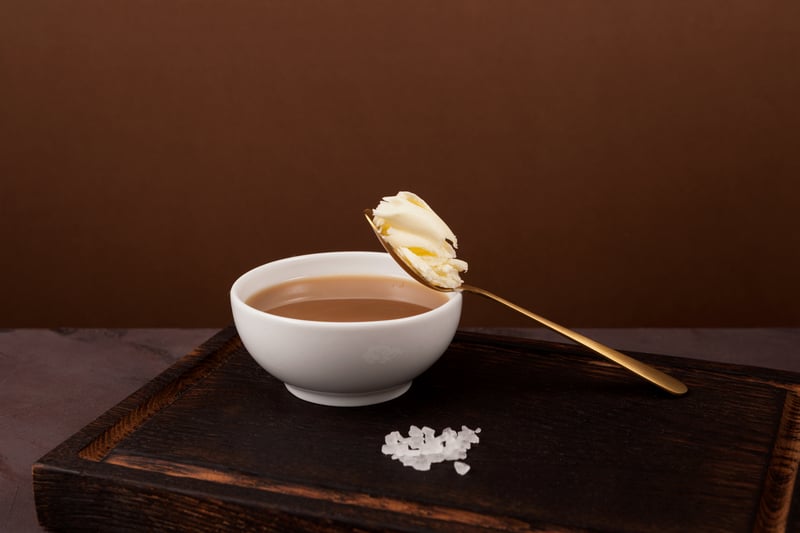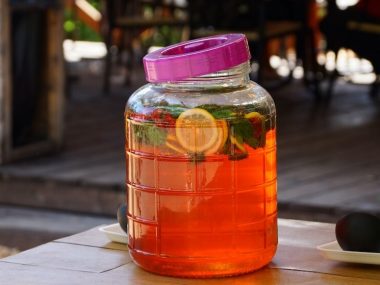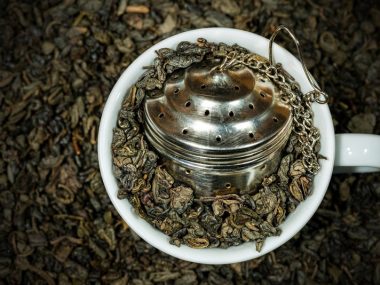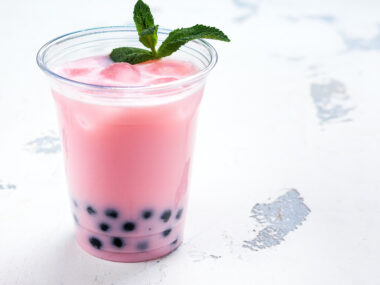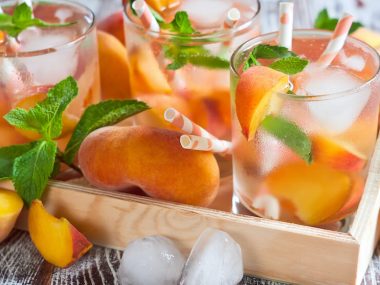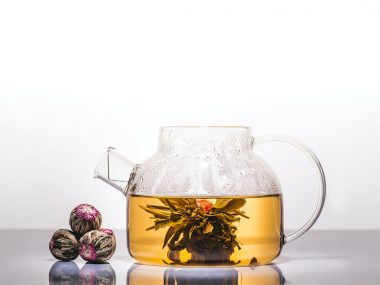Could it be possible for dirty yak hair to flavor a tea many climbers drink just before scaling Mt. Everest? Now we have your curiosity piqued!
Table of Contents
What Is Butter Tea?
One of the first questions our readers ask about this tea is, “What is butter tea made of?” It’s not common to find a tea with butter incorporated into it. To make this tea more of an oddity, it’s made with yak butter!
What Is Yak Butter?
Yak butter isn’t something you’ll readily find in the dairy section of the local grocery store. This butter is unique to Tibet. Yak butter is made from the milk of a female yak (a hairy-looking cow with horns.)
Before we go any further into yak butter, it helps to first understand more about the source of yak butter, which is the yak. Yaks are bovine animals belonging to Bos grunniens (a species related to cows and buffalo.)
Yaks are Tibet’s equivalent to our cow and are heavily relied upon by almost all Tibetans who own a yak. Domesticated yaks are sources of yak butter, meat, milk, manure for fuel, lighting, and more and are, for many, their only source of income. The yak is endemic to Tibet and other extreme elevations. It easily thrives in oxygen-deprived altitudes where it feeds on nothing more than scraggly grasses or shrubs that grow in such hostile conditions.
Yak Butter Culture
Yak butter, like most any other butter, is made from milk. In westernized cultures, we are accustomed to sweet butter made from the milk of a cow. Tibetans milk their female yak and then take that milk to make butter.
Yak butter isn’t merely a food item in Tibet; it is used as a lighting source because of its high-fat content. Tibetans also use yak milk and yak butter as a binder for medicines. More importantly, yak butter is considered holy and provides lighting (in butter lamps) for religious ceremonial gatherings.
Yak butter looks and feels like cheese. It is formed into bricks and stored in homes or taken to local villages where Tibetans sell them. The leading use of this butter is to make butter tea. This tea draws the attention of tourists whose curiosity leads them to drink the tea.
Yak Butter Tea
Alas, we finally arrive at the featured tea that is what some would call “a feature of atlas obscura!” It raises the question about why on earth would anyone drink this tea? It sounds rather disgusting. However, before we make assumptions about the taste of this tea, let’s keep unpacking it to fully appreciate this drink!
Traditional Yak Butter Tea
Traditional Tibetan yak butter tea is made with puerh tea, boiling water salt, and yak butter. Puerh tea is a highly fermented, processed tea with infinite layers of flavor. By marrying this tea with the creamy butter element and salt, you have yourself a very interesting cup of tea.
A traditional Tibetan home prepares yak butter tea in a very simple manner. The puerh tea leaves are brewed in earthenware for several hours (rather than a few minutes) to create a highly concentrated tea soup called “chaku.”
Salt is then added and stirred until dissolved. Yak butter is sliced and added to the top of the chaku, where it slowly melts. The tea mixture gets poured into a tea container (jiadong) through a bamboo strainer (jiaza.) The tea barrel is equipped with a stirring stick (jialuo) to complete the tea by vigorous stirring. The tea then gets poured into cups to enjoy.
Sweet Yak Butter Tea
Most Tibetans drink the traditional style of this tea. Its sweet counterpart was the result of the British army invasion into Tibet hundreds of years ago. The British soldiers grew to love yak butter tea with sugar instead of salt because they were accustomed to adding sugar to their tea.
Why Do People Drink Butter Tea?
Tibetans live in a hostile environment where the terrain is steep, the altitudes (4,000+ meters) have less oxygen, and temperatures are harshly frigid. Because the yak is native to such conditions, Tibetans rely on this animal.
The yak is integral in the diet of Tibetans and other areas of their lives. The high-fat content in yak butter provides Tibetans a source of energy. Yak butter tea is also warming and satisfying, taking the chill from the bones.
Aside from the daily consumption of this tea, Tibetans honor the loss of life during a funeral by placing yak butter and yak butter tea on a table that is placed near the body. Funeral attendees bring pitchers of the tea to the funeral and pour it into a larger pitcher sitting on the table. Failing to empty the contents of the pitcher into the funeral pitcher is said to cause bad luck.
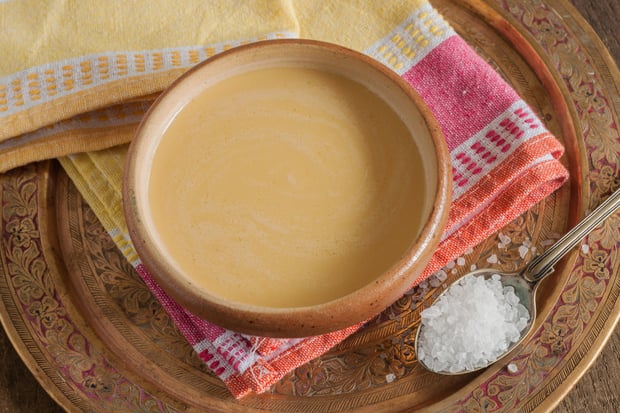
What Does Butter Tea Taste Like?
Someone who tries yak butter tea for the first time will typically experience a fatty coating on the inside of the mouth because of the high-fat content in yak milk. The milk itself requires a certain palate as it can taste a bit “gamey.”
One might describe it as a transference of yak odor with a grassy overtone. However, don’t let this discourage you from trying butter tea because further down, we will give you a more westernized way to try this tea without the essence of yak.
Is It Okay To Drink Butter Tea Every Day?
Most of us would not consume yak butter tea daily because we don’t own a yak or live in Tibet. If we do happen to have a yak in our backyard to make yak butter from, or we visit or live in Tibet and drink yak butter tea daily, you can bet it will pack on the pounds.
Is Butter Tea Good For Health?
With butter tea being sinfully creamy and packed with fat, it raises the question about the health benefits this tea delivers. To adequately determine how healthy this tea is, we have to break it down by each ingredient.
Milk
The Food and Nutrition Research Journal published an article mentioning how beneficial milk and dairy are. Consuming milk reduces the risk of Type II diabetes and cardiovascular disease. Bones particularly benefit from the intake of milk. Bone density is built up, leading to a decrease in fractures.
For those trying to lose weight, drinking milk provides a source of protein that facilitates weight loss and a reduction in BMI (body mass index.)
Salt
The World Health Organization recognizes that consuming up to 5 grams of salt daily reduces blood pressure and the risk of cardiovascular diseases that lead to stroke and heart attack.
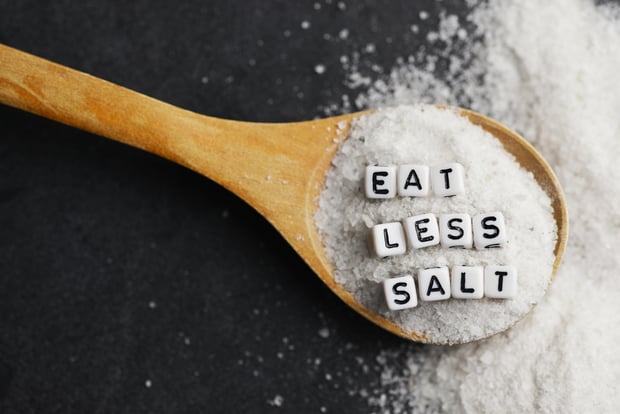
Puerh Tea
It is noted in the Clinical Interventions On Aging Journal that puerh tea plays a role in weight loss and a reduction in hunger and cholesterol.
Why Is Butter Tea Bad For You?
If you are lactose intolerant or have high cholesterol or cardiovascular conditions, this tea may not be for you. Because puerh tea is the base of this drink, it’s always best to talk to your healthcare provider to make sure consuming tea is safe for you personally.
Tea can worsen existing medical conditions, interact with medications (including chemotherapy or radiation,) cause adverse reactions or side effects.
How To Make Butter Tea
We have two ways to experience butter tea. The first recipe is for a tried and true yak butter tea, while the second is for those of us who don’t have a yak or prefer something a bit more palatable.
Traditional Tibetan Yak Butter Tea Recipe
If you just happen to have a yak out back, you’ve got the makings for a nice cup of yak butter tea!
Ingredients
- 4 cups of water
- 1 miniature puerh cake
- 2 tablespoons of yak butter
- ¼ teaspoon of Himalayan salt
Directions
- Place the water and puerh cake into a large pan.
- Simmer for two hours.
- Remove from the heat.
- Add the salt and stir until thoroughly dissolved.
- Add the yak butter and allow it to melt.
- Stir well.
- Pour into cups and enjoy.
Buttery Genmaicha Tea Recipe
We have a savory tea to enjoy as a western alternative to yak butter tea. It’s all about experiencing butter’s comforting and creamy goodness in a cup of tea. Genmaicha is a green tea with roasted rice.
Ingredients
- 2 cups of water
- 2 teaspoons of genmaicha loose-leaf tea
- ½ teaspoon of pure sweet/salted butter
- ¼ cup of milk (your choice of dairy milk)
Directions
- Heat the water to 185 degrees (F) (85 degrees C.)
- Remove from the heat.
- Place the loose leaf tea into a tea infuser.
- Drop the infuser into a teapot.
- Pour the hot water into the teapot.
- Cover and allow the tea to steep for 5 minutes.
- Remove the cover and tea infuser.
- Add the milk and butter to the teapot and stir well.
- Pour into a cup and enjoy!
Yuck Or Yak?
Butter tea is either a tea you like or dislike. Kudos to you if you have tried Tibetan yak butter tea! Why not go out on a limb and try butter in your next cup of tea?
